Jeep Cherokee (XJ): Rear axle. Pinion shaft seal. Collapsible spacer
REMOVAL (1) Raise and support the vehicle.
(2) Position a suitable lifting device under the
axle.
(3) Secure axle to device.
(4) Remove the wheels and tires.
(5) Remove the brake drums from the axle. Refer
to Group 5, Brakes, for proper procedures.
(6) Disconnect parking brake cables from brackets
and lever.
(7) Remove wheel speed sensors, if necessary.
Refer to Group 5, Brakes, for proper procedures.
(8) Disconnect the brake hose at the axle junction
block. Do not disconnect the brake hydraulic lines at
the wheel cylinders. Refer to Group 5, Brakes, for
proper procedures.
(9) Disconnect the vent hose from the axle shaft
tube.
(10) Mark the propeller shaft and yokes for installation
alignment reference.
(11) Remove propeller shaft.
(12) Disconnect stabilizer bar links.
(13) Disconnect shock absorbers from axle.
(14) Remove the U-bolts which hold the axle to the
spring brackets.
(15) Separate the axle from the vehicle. INSTALLATION NOTE: The weight of the vehicle must be supported
by the springs before suspension arms and
track bar fasteners can be tightened. If the springs
are not at their normal ride position, vehicle ride
height and handling could be affected.
(1) Raise the axle with lifting device and align the
spring centering bolts with the mating holes in the
axle spring perch.
(2) Install the U-bolts which hold the axle to the
spring brackets. Tighten nuts to 70 N·m (52 ft. lbs.).
(3) Install shock absorbers and tighten nuts to 60
N·m (44 ft. lbs.) torque.
(4) Install stabilizer bar links and tighten nuts to
74 N·m (55 ft. lbs.) torque.
(5) Install the wheel speed sensors, if necessary.
Refer to Group 5, Brakes, for proper procedures.
(6) Connect parking brake cable to brackets and
lever.
(7) Install the brake drums. Refer to Group 5,
Brakes, for proper procedures.
(8) Connect the brake hose to the axle junction
block. Refer to Group 5, Brakes, for proper procedures.
(9) Install axle vent hose.
(10) Align propeller shaft and pinion yoke reference
marks. Install U-joint straps and bolts. Tighten
to 19 N·m (14 ft. lbs.) torque.
(11) Install the wheels and tires.
(12) Add gear lubricant, if necessary. Refer to
Lubricant Specifications in this section for lubricant
requirements.
(13) Remove lifting device from axle and lower the
vehicle. REMOVAL (1) Raise and support the vehicle.
(2) Remove wheel and tire assemblies.
(3) Remove the brake drums. Refer to Group 5,
Brakes, for proper procedures.
(4) Mark the propeller shaft and pinion yoke for
installation alignment reference.
(5) Remove the propeller shaft from the yoke.
(6) Rotate the pinion gear three or four times.
(7) Measure the amount of torque necessary to
rotate the pinion gear with a (in. lbs.) dial-type
torque wrench. Record the torque reading for installation
reference.
(8) Using Holder 6958 to hold the pinion yoke,
remove the pinion nut and washer.
(9) Use Remover C-452 and Wrench C-3281 to
remove the pinion yoke (Fig. 7).
1 - SPECIAL TOOL C-3281 (10) Use a suitable pry tool or slide hammer
mounted screw to remove the pinion gear seal. INSTALLATION (1) Apply a light coating of gear lubricant on the
lip of pinion seal. Install seal with Installer C-3972-A
and Handle C-4171 (Fig. 8).
1 - SPECIAL TOOL C-4171 (2) Install yoke on the pinion gear with Screw
8112, Cup 8109, and Holder 6958 (Fig. 9).
CAUTION: Do not exceed the minimum tightening
torque when installing the pinion yoke at this point.
Damage to the collapsible spacer or bearings may
result.
(3) Install the yoke washer and a new nut on the
pinion gear and tighten the pinion nut until there is
zero bearing end-play.
(4) Tighten the nut to 271 N·m (200 ft. lbs.).
1 - PINION YOKE CAUTION: Never loosen pinion gear nut to
decrease pinion gear bearing rotating torque and
never exceed specified preload torque. If preload
torque or rotating torque is exceeded a new collapsible
spacer must be installed. The torque
sequence will then have to be repeated.
(5) Rotate the pinion shaft using a (in. lbs.) torque
wrench. Rotating torque should be equal to the reading
recorded during removal plus an additional 0.56
N·m (5 in. lbs.) (Fig. 10).
1 - PINION YOKE (6) If the rotating torque is low, use Holder 6958 to
hold the pinion yoke (Fig. 11), and tighten the pinion
shaft nut in 6.8 N·m (5 ft. lbs.) increments until the
proper rotating torque is achieved.
CAUTION: If the maximum tightening torque is
reached prior to reaching the required rotating
torque, the collapsible spacer may have been damaged.
Replace the collapsible spacer.
(7) Align the installation reference marks on the
propeller shaft and yoke and install the propeller
shaft.
(8) Add gear lubricant to the differential housing,
if necessary. Refer to the Lubricant Specifications for
gear lubricant requirements.
(9) Install the brake drums. Refer to Group 5,
Brakes, for proper procedures.
(10) Install wheel and tire assemblies.
1 - SPECIAL TOOL 6958 (11) Lower the vehicle. REMOVAL W/PINION INSTALLED (1) Raise and support the vehicle.
(2) Remove wheel and tire assemblies.
(3) Remove rear brake drums. Refer to Group 5,
Brakes, for proper procedures.
(4) Mark the propeller shaft and pinion yoke for
installation reference.
(5) Remove the propeller shaft from the yoke.
(6) Rotate the pinion gear three or four times.
(7) Measure the amount of torque necessary to
rotate the pinion gear with a (in. lbs.) dial-type
torque wrench. Record the torque reading for installation
reference.
(8) Using Holder 6958 to hold the pinion yoke,
remove the pinion nut and washer.
(9) Use Remover C-452 and Wrench C-3281 to
remove the pinion yoke (Fig. 12).
(10) Use a suitable pry tool or a slide hammer
mounted screw to remove the pinion shaft seal.
(11) Remove the front pinion bearing using a pair of
suitable pick tools to pull the bearing straight off the
pinion gear shaft. It may be necessary to lightly tap the
end of the pinion gear with a rawhide or rubber mallet
if the bearing becomes bound on the pinion shaft.
(12) Remove the collapsible spacer. REMOVAL W/PINION REMOVED (1) Raise and support the vehicle.
(2) Remove wheel and tire assemblies.
(3) Remove rear brake drums. Refer to Group 5,
Brakes, for proper procedures.
(4) Mark the propeller shaft and pinion yoke for
installation reference.
1 - SPECIAL TOOL C-3281 (5) Remove the propeller shaft from the yoke.
(6) Rotate the pinion gear three or four times.
(7) Measure the amount of torque necessary to
rotate the pinion gear with a (in. lbs.) dial-type
torque wrench. Record the torque reading for installation
reference.
(8) Remove differential assembly from axle housing.
(9) Using Holder 6958 to hold yoke, remove the
pinion yoke nut and washer.
(10) Using Remover C-452 and Wrench C-3281,
remove the pinion yoke from pinion shaft (Fig. 12).
(11) Remove the pinion gear from housing (Fig.
13). Catch the pinion with your hand to prevent it
from falling and being damaged.
(12) Remove collapsible spacer from pinion shaft. INSTALLATION (1) Install a new collapsible preload spacer on pinion
shaft (Fig. 14).
(2) If pinion gear was removed, install pinion gear
in housing.
(3) Install pinion front bearing, if necessary.
(4) Apply a light coating of gear lubricant on the
lip of pinion seal. Install seal with Installer C-3972-A
and Handle C-4171 (Fig. 15).
(5) Install yoke with Screw 8112, Cup 8109, and
Holder 6958 (Fig. 16).
(6) If the original pinion bearings are being used,
install differential assembly and axle shafts, if necessary.
1 - RAWHIDE HAMMER
1 - COLLAPSIBLE SPACER
1 - SPECIAL TOOL C-4171 NOTE: If new pinion bearings were installed, do not
install the differential assembly and axle shafts until
after the pinion bearing preload and rotating torque
are set.
1 - PINION YOKE 7) Install the yoke washer and a new nut on the
pinion gear. Tighten the pinion nut until there is zero
bearing end-play.
(8) Tighten the nut to 271 N·m (200 ft. lbs.).
CAUTION: Never loosen pinion gear nut to
decrease pinion gear bearing rotating torque and
never exceed specified preload torque. If preload
torque or rotating torque is exceeded a new collapsible
spacer must be installed. The torque
sequence will then have to be repeated.
(9) Using yoke holder 6958 and a torque wrench
set at 474 N·m (350 ft. lbs.), crush collapsible spacer
until bearing end play is taken up (Fig. 17).
NOTE: If more than 474 N·m (350 ft. lbs.) of torque
is necessary to remove the bearing end play, the
collapsible spacer is defective and must be
replaced. (10) Slowly tighten the nut in 6.8 N·m (5 ft. lbs.)
increments until the rotating torque is achieved.
Measure the rotating torque frequently to avoid over
crushing the collapsible spacer (Fig. 18).
1 - SPECIAL TOOL 6958 (11) Check rotating torque with a (in. lbs.) torque
wrench (Fig. 18). The torque necessary to rotate the
pinion gear should be: (12) Install differential assembly and axle shafts,
if necessary.
(13) Align marks made previously on yoke and
propeller shaft and install propeller shaft.
(14) Install rear brake drums. Refer to Group 5,
Brakes, for proper procedures.
(15) Add gear lubricant, if necessary. Refer to
Lubricant Specifications of this section for lubricant
requirements.
(16) Install wheel and tire assemblies.
(17) Lower vehicle.Rear axle
Pinion shaft seal
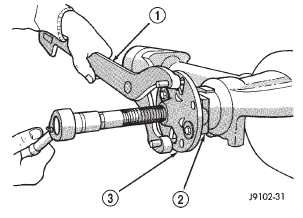
Fig. 7 Pinion Yoke Removal
2 - YOKE
3 - SPECIAL TOOL C-452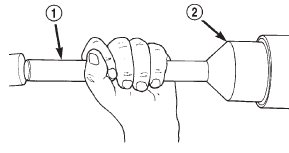
Fig. 8 Pinion Seal Installation
2 - SPECIAL TOOL C-3972-A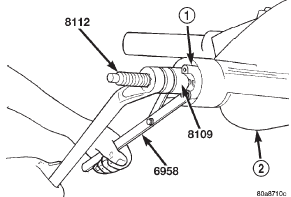
Fig. 9 Pinion Yoke Installation
2 - AXLE HOUSING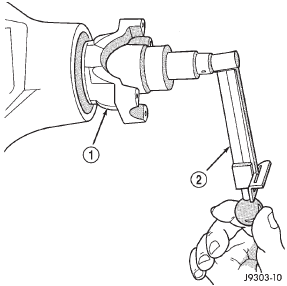
Fig. 10 Check Pinion Rotation Torque
2 - INCH POUND TORQUE WRENCH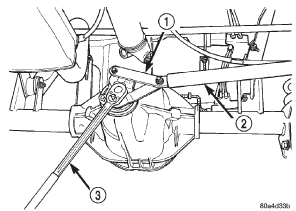
Fig. 11 Tightening Pinion Shaft Nut-Typical
2 - 1 in. PIPE
3 - 3/4 DRIVE TORQUE WRENCHCollapsible spacer
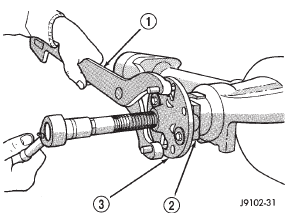
Fig. 12 Pinion Yoke Removal
2 - YOKE
3 - SPECIAL TOOL C-452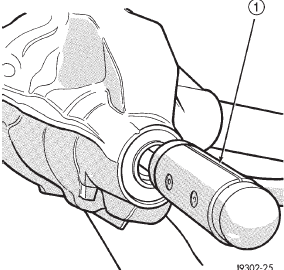
Fig. 13 Remove Pinion Gear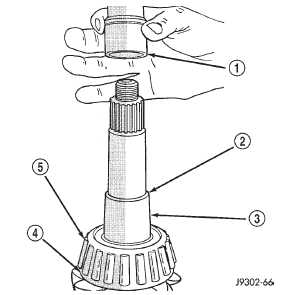
Fig. 14 Collapsible Preload Spacer
2 - SHOULDER
3 - PINION GEAR
4 - OIL SLINGER
5 - REAR BEARING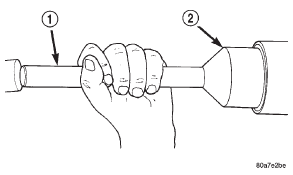
Fig. 15 Pinion Seal Installation
2 - SPECIAL TOOL C-3972-A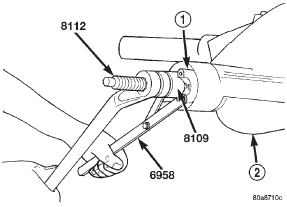
Fig. 16 Pinion Yoke Installation
2 - AXLE HOUSING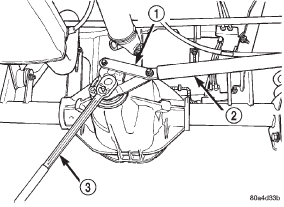
Fig. 17 Tightening Pinion Nut-Typical
2 - 1 in. PIPE
3 - 3/4 DRIVE TORQUE WRENCH
 Axle shaft. Axle shaft seal and bearing. Differential
Axle shaft. Axle shaft seal and bearing. Differential
Other materials:
Spark plug cables. Spark plugs. Ignition coil-2.5L engine
Spark plug cables
REMOVAL
CAUTION: When disconnecting a high voltage
cable from a spark plug or from the distributor cap,
twist the rubber boot slightly (1/2 turn) to break it
loose (Fig. 18). Grasp the boot (not the cable) and
pull it off with a steady, even force.
INSTALLATION
Push the cabl ...

